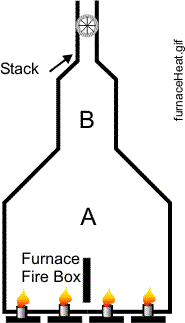 |
Major Furnace Components
In spite of many differences, many furnaces have a few common features. In the following sections we will discuss some of the features which are commonly found in furnaces.
Firebox
The region of the furnace designed to contain actual fire is referred to as the “firebox”. This region is widest region in a furnace, and it is easily identifiable. Since the actual combustion takes place in this region, it experiences the highest temperature. Combustion of some fuel oils can create a temperature as high as 2000 deg F (1090 deg C). To keep the combustion heat inside the furnace, fireboxes are lined with refractory bricks. These bricks serve the following purposes:
a. Contain the heat inside the firebox cavity.
b. Provide insulation to protect operators and other workers. (Other insulation is also used for this purpose).
c. Provide a hard surface which can withstand the necessary wear and tear (some combustion products are corrosive substances)
d. Reflect the radiant heat back into the furnace, so that it can be absorbed by the radiant tubes. “Radiant tubes” are defined as those tubes which carry the substance to be heated, and are installed in a manner which exposes them to radiant heat.